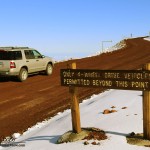Found among the recent legislation proposed for the 2018 session is HB1767 Related to Motor Vehicles. The bill caught my attention when searching for proposed legislation affecting Mauna Kea. As the issues that swirl about our mauna are high profile there is no surprise that there are multiple bills that turned up in my search.

It is this second provision that really caught my attention. This is something to look twice at and wonder what the effects of this particular legislation might be.
I have written extensively on the issues of 4WD and accessing the summit of Mauna Kea previously.
- Visiting the Summit of Mauna Kea
- Public Access to Mauna Kea
- 4WD and Washboard on Mauna Kea
- Tragedy on Mauna Kea
Both of these roads are currently posted for 4WD use only, very conspicuously in both cases. There is no legal basis I am aware for these signs, they are posted as such as a precaution to the drivers. Drive these roads in a non-4WD vehicle and you will not be cited. The risk is in the resulting large towing bill, potentially the better part of a thousand dollars, to recover the vehicle.
It is possible to ascend the summit of Mauna Kea in a non-4WD passenger car, in the vast majority of cases without trouble. As long as the car is in good repair and not driven too hard the vehicle will survive the experience. Waipio Valley is a different matter, the access road from the valley floor simply too steep a grade for many passenger vehicles to ascend. Removal of the vehicle from the valley often requires a tow truck.

Rather the usual cause of accidents on Mauna Kea is in not using engine braking to descend, riding the brakes until they overheat and fail. The latest two fatalities happened despite driving a 4WD vehicle. Those of us who drive to the summit regularly never use 4WD low gear, simply using first and second in 4WD-auto or 4WD-high.
Are non-4WD vehicles more likely to break down on the summit road? Probably. But my non-scientific look through the recent break downs reported by the rangers shows almost all trucks. Certainly all recent serious accidents, including fatalities, have been trucks.
A few other quibbles… The bill makes no distinction between private or commercial vehicles in the 4WD requirement. Odd, as many of the trucks that visit the summit regularly are not “low gear four-wheel drive vehicle” as specified by the plain language of the current revision. The semi-tractor trailers used to deliver heavy equipment to the summit may have low gears, but are typically rear-wheel drive only, the very definition of “semi”.

The more I review this issue, the more I wonder if this legislation is needed. It seems odd that Waipio Valley is included in the bill to start with. As if the legislation is truly targeted at Mauna Kea, with Waipio added as a diversionary tactic. Requiring low-gear 4WD on Mauna Kea is in part a back-door method of restricting access to the summit, of reducing the number of visitors using the summit road and the impact on the summit.
Reducing the number of visitors to the summit is arguably a worthwhile goal, can we at least be honest while doing it?
While Waipio Valley is largely self enforcing, no legislation really needed, the summit of Mauna Kea has proven accessible to non-4WD vehicles. Given the significant number of non-4WD vehicles using the summit road and the lack of enforcement authority the reason for this legislation is obvious, having little to do with safety, more to do with restricting access.

